🐶 Basenji Hypoallergenic Guide ✅The Barkless Wonder: Character, Grooming & Suitability 
🟠 Hypoallergenic Level: Partially Hypoallergenic
🏷️ Key Characteristics↑ Back to MenuEssential Basenji InformationSize: Small to Medium
Weight: 9-11 kg (20-24 lbs)
Height: 38-43 cm (15-17 inches)
Lifespan: 12-16 years
Activity Level: High
Grooming Needs: Low
Hypoallergenic: Partially
Shedding: Minimal
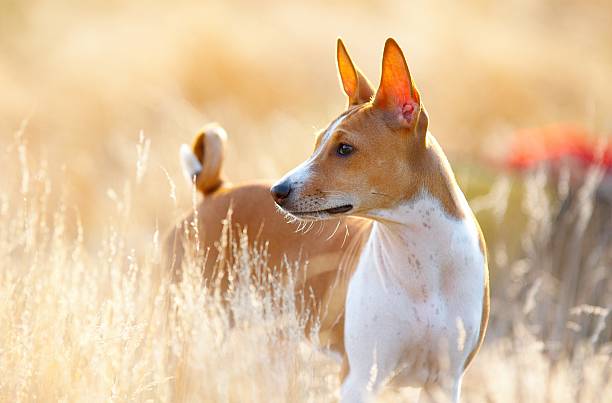
Basenji displaying its elegant stance in natural surroundings
🏛️ Origin & History↑ Back to MenuThe Basenji is one of the world's oldest and most fascinating dog breeds, with a history that traces back thousands of years to Central Africa. Ancient Egyptian artifacts and tomb paintings depict dogs remarkably similar to modern Basenjis, suggesting these elegant canines were treasured companions of pharaohs. The breed's name derives from the Lingala word "mbwá na basɛ́nzi," meaning "dogs of the villagers" or "dogs of the bush people." 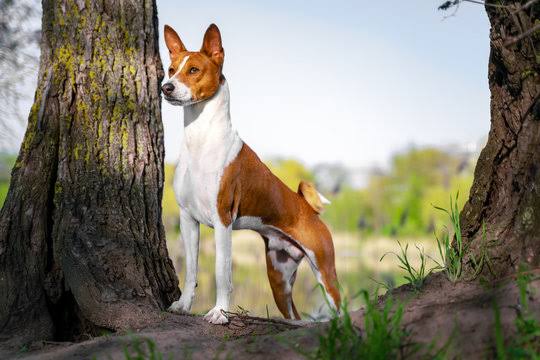
The Basenji's alert expression reflects its ancient hunting heritage
In their native Congo region, Basenjis were prized hunting dogs, valued for their intelligence, speed, and remarkable silence during hunts. Unlike most dogs, Basenjis don't bark due to their unusually shaped larynx. Instead, they produce a unique sound called a "baroo" or yodel. This characteristic made them particularly effective for hunting, as they could track game without alerting prey from a distance. The breed was first brought to England in the late 1930s and subsequently to the United States in the 1940s. Despite initial breeding challenges and setbacks, dedicated breeders persevered, and the American Kennel Club officially recognized the Basenji in 1943. Today, while still relatively rare compared to other breeds, Basenjis have gained a devoted following worldwide, appreciated for their unique characteristics, intelligence, and cat-like grooming habits. 💕 Character & Temperament↑ Back to Menu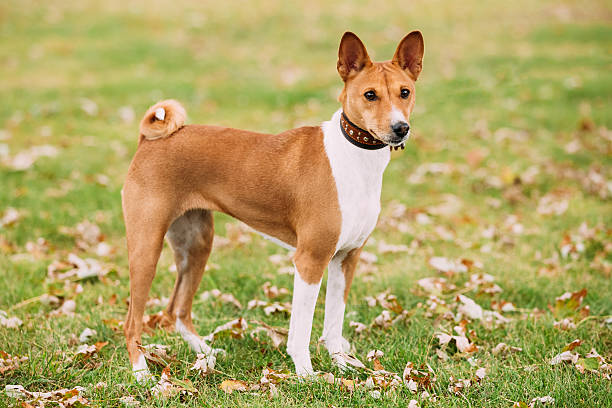
A confident Basenji displaying its independent yet playful nature
The Basenji possesses a fascinating and complex personality that sets it apart from most other breeds. Often described as having cat-like qualities, these dogs are remarkably independent, intelligent, and fastidious about cleanliness. They groom themselves meticulously and are known for their dignified, almost aloof demeanor with strangers. Despite their independence, Basenjis form strong bonds with their families and can be affectionate and playful with those they trust. They are curious and alert, always investigating their surroundings with keen interest. However, this inquisitive nature, combined with their high intelligence, means they can be quite mischievous. Basenjis are notorious escape artists and problem-solvers who will find creative ways to get what they want. 
Basenjis are highly attentive and perceptive companions
The breed's stubbornness and independence can make training challenging. Basenjis are not naturally obedient like some working breeds; they prefer to think for themselves and may question commands. Positive reinforcement training works best, though patience and consistency are essential. Early socialization is crucial to help them develop appropriate social skills with other dogs and people. ⚠️ Important Temperament NoteBasenjis have a strong prey drive inherited from their hunting heritage. They should never be trusted off-leash in unfenced areas, as they may chase small animals and ignore recall commands. Secure fencing is absolutely essential. 👀 Physical Appearance↑ Back to MenuThe Basenji is a small, elegantly built dog with a distinctive square profile and graceful, athletic appearance. Their most striking feature is their tightly curled tail, which sits proudly over their back. The breed's head is wedge-shaped with erect, pointed ears that give them an alert, intelligent expression. 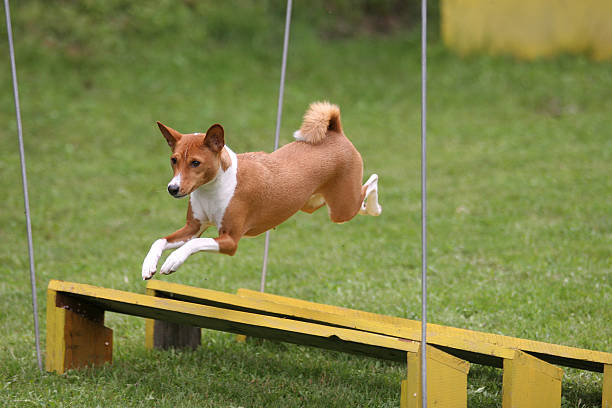
Athletic Basenji demonstrating remarkable agility and grace
One of the breed's most charming features is the wrinkled forehead, which becomes particularly pronounced when the dog is alert or curious. Their dark, almond-shaped eyes convey intelligence and attentiveness. The Basenji's short, fine coat lies close to the body and has a lustrous sheen, requiring minimal grooming.
The breed's compact size and athletic build reflect their heritage as agile hunting dogs. Despite their small stature, Basenjis are muscular and surprisingly powerful, capable of impressive speed and endurance. Their overall appearance conveys elegance, balance, and alertness. 🏃 Activity Needs↑ Back to Menu
Even young Basenjis display curiosity and energy
Basenjis are highly energetic dogs that require substantial daily exercise and mental stimulation. Their hunting heritage means they have impressive stamina and a strong desire to run and explore. A tired Basenji is a well-behaved Basenji, while an under-exercised one may become destructive or develop behavioral problems. Daily exercise requirements include at least 60-90 minutes of activity, which can be divided into multiple sessions. This should include brisk walks, jogging, or play sessions in a securely fenced area. Basenjis excel at various dog sports including lure coursing, agility, and tracking, which provide excellent outlets for their energy and instincts.
⚡ Exercise Safety WarningNever trust a Basenji off-leash in unfenced areas. Their prey drive is so strong that even well-trained dogs may ignore recall commands when they spot something to chase. A 6-foot fence is the minimum recommendation, and some Basenjis can clear even higher barriers. Beyond physical exercise, Basenjis need mental challenges to stay happy and well-adjusted. Interactive puzzle toys, training sessions, and games that engage their problem-solving abilities are essential. Without adequate mental stimulation, these intelligent dogs may invent their own entertainment, often in ways owners find less than desirable. ✂️ Grooming Care↑ Back to Menu
Basenjis maintain their elegant appearance with minimal grooming
One of the Basenji's greatest appeals is their remarkably low grooming requirements. Their short, fine coat sheds minimally and lacks the typical "dog odor" that many breeds produce. Basenjis are fastidious self-groomers, much like cats, which contributes to their cleanliness and makes them particularly suitable for people seeking low-maintenance dogs. Coat CareThe Basenji's coat requires only weekly brushing with a soft-bristle brush or grooming mitt to remove loose hair and distribute natural oils. During their twice-yearly shedding seasons (spring and fall), slightly more frequent brushing may be beneficial, though even seasonal shedding is minimal compared to most breeds. 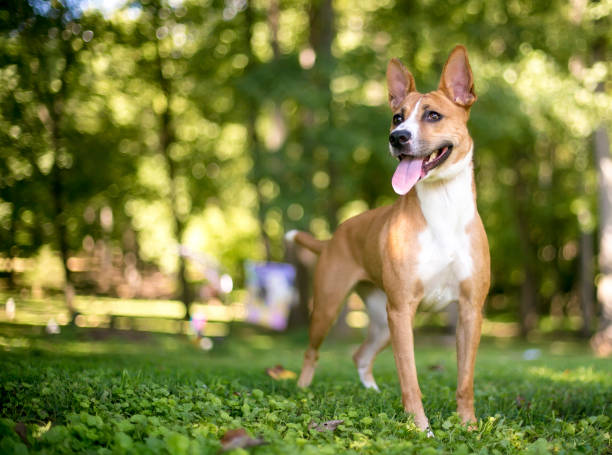
A healthy, well-maintained Basenji enjoying outdoor activity
BathingBasenjis rarely need baths due to their self-cleaning habits and lack of doggy odor. Bathing every 3-4 months is typically sufficient, or as needed if they get particularly dirty. Over-bathing can strip the coat's natural oils and cause skin dryness. When bathing is necessary, use a mild dog shampoo and ensure thorough rinsing. 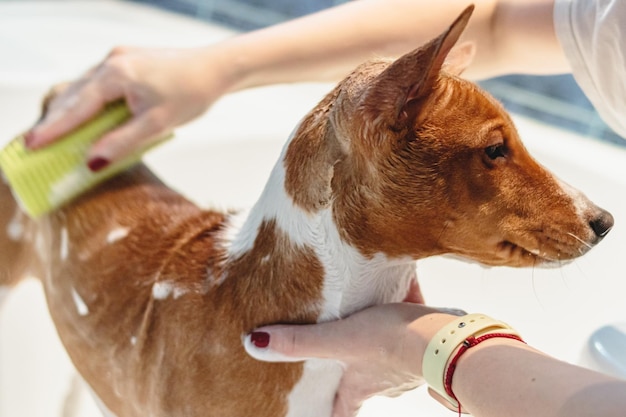
Occasional bathing keeps your Basenji fresh and clean
Other Grooming NeedsNail trimming should be performed every 3-4 weeks, as Basenjis' nails grow quickly. Regular dental care is essential; daily tooth brushing is ideal, though 3-4 times weekly is acceptable. Check ears weekly for signs of infection, redness, or odor, and clean with a veterinarian-approved solution when necessary. 🧼 Hypoallergenic Grooming NoteWhile Basenjis are partially hypoallergenic due to minimal shedding and low dander production, regular grooming still helps reduce allergen levels. Wiping down your Basenji with a damp cloth weekly can further minimize dander distribution in your home. 🍽️ Nutrition Needs↑ Back to MenuBasenjis require a high-quality, balanced diet appropriate for their age, size, and activity level. As active, athletic dogs with lean builds, they benefit from protein-rich food that supports their muscle mass and energy requirements. The typical adult Basenji needs approximately 1 to 1.5 cups of quality dry dog food daily, divided into two meals.
The exact amount depends on your dog's metabolism, activity level, and the caloric density of the food chosen. Active Basenjis participating in dog sports may require more food, while less active or older dogs may need less to prevent weight gain. Always provide fresh, clean water at all times. ⚠️ Health ConsiderationBasenjis are prone to Fanconi syndrome, a kidney disorder that can be managed with diet and supplements if detected early. Regular veterinary check-ups and urine strip testing are recommended. Some Basenjis also have food sensitivities, so monitor for any digestive issues when introducing new foods. Avoid overfeeding, as Basenjis can become overweight despite their athletic appearance. Monitor your dog's body condition regularly—you should be able to feel but not prominently see their ribs. Treats should comprise no more than 10% of daily caloric intake. Avoid feeding human foods that are toxic to dogs, including chocolate, grapes, onions, and xylitol. 🔍 Discover Your Ideal Hypoallergenic MatchConsidering a Basenji but want to explore all your hypoallergenic options? Our interactive breed selector tool evaluates your lifestyle, living situation, and allergy concerns to recommend the perfect breeds for your family. Find your perfect hypoallergenic companion in just 2 minutes! 👨👩👧👦 Suitable For↑ Back to Menu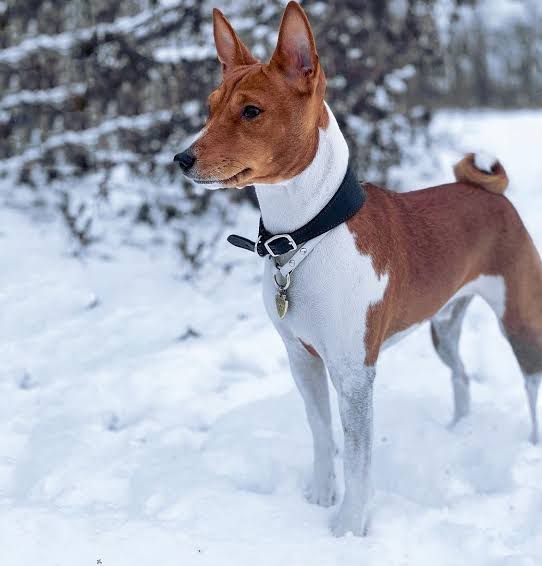
Basenjis adapt well to various climates with proper care
Families with ChildrenBasenjis can be good family dogs, but they are best suited for families with older, respectful children (generally ages 10 and up). These dogs have low tolerance for rough handling, sudden movements, or loud noises that young children often make. They may snap or withdraw if they feel threatened or uncomfortable. With older children who understand how to interact appropriately with dogs, Basenjis can form wonderful bonds and become devoted companions. Apartment LivingDespite their high energy levels, Basenjis can adapt well to apartment living with certain conditions. Their small size, minimal shedding, and lack of excessive barking make them suitable for close-quarters living. However, they require committed owners who will provide adequate daily exercise and mental stimulation. Without sufficient activity, apartment-dwelling Basenjis may become destructive or develop behavioral issues. Access to secure outdoor spaces for exercise is essential. First-Time vs. Experienced OwnersBasenjis are not recommended for first-time dog owners. Their independent nature, stubbornness, high intelligence, and strong prey drive present significant training challenges. They require patient, consistent, experienced handlers who understand positive reinforcement methods and won't be frustrated by the breed's characteristic independence. Experienced dog owners who appreciate the breed's unique qualities and are prepared for training challenges will find Basenjis rewarding companions.
🏠 Ideal Basenji Owner ProfileThe perfect Basenji owner is active, patient, and experienced with independent dog breeds. They have secure outdoor space, time for daily exercise and training, and appreciate the breed's unique cat-like personality. They're not seeking an obedient, eager-to-please companion, but rather an intelligent, independent partner. ⚖️ Pros & Cons↑ Back to Menu✅ Advantages
❌ Challenges
❓ Frequently Asked Questions↑ Back to MenuAre Basenjis truly hypoallergenic?Basenjis are partially hypoallergenic, not completely hypoallergenic. They produce less dander than many breeds and shed minimally, which can make them suitable for some allergy sufferers. However, no dog is 100% hypoallergenic, as all dogs produce some level of allergens through dander, saliva, and urine. People with dog allergies should spend time with Basenjis before committing to ensure compatibility. Do Basenjis really not bark?Correct—Basenjis don't bark in the traditional sense due to their uniquely shaped larynx. Instead, they produce a distinctive yodeling sound called a "baroo" when excited or communicating. They also whine, growl, and make various other vocalizations. While they're quieter than barking breeds, they're not silent dogs. Are Basenjis difficult to train?Yes, Basenjis are among the most challenging breeds to train. Their intelligence combined with extreme independence and stubbornness means they often question commands and choose when to comply. They respond best to positive reinforcement and short, varied training sessions. Patience, consistency, and realistic expectations are essential. They're not suitable for owners seeking obedient, eager-to-please companions. Can Basenjis live with cats or other small pets?This varies significantly by individual dog. Basenjis have a very strong prey drive, and many will chase and potentially harm small animals. Some Basenjis raised with cats from puppyhood can coexist peacefully, but caution is always necessary. They should never be trusted alone with small pets like rabbits, guinea pigs, or birds. Early socialization and careful supervision are critical. How much exercise does a Basenji need?Basenjis require 60-90 minutes of exercise daily, divided into multiple sessions. This should include walks, running opportunities in secure areas, and mental stimulation through training or puzzle toys. Without adequate exercise, they become destructive and develop behavioral problems. They excel at dog sports like lure coursing and agility. Are Basenjis good for first-time dog owners?No, Basenjis are not recommended for first-time owners. Their independence, stubbornness, high prey drive, and training challenges require experienced handlers who understand working with independent breeds. First-time owners may find themselves overwhelmed and frustrated by the Basenji's unique temperament. Do Basenjis get along with other dogs?Basenjis can get along with other dogs, but early and extensive socialization is crucial. They can be dominant and selective about canine companions. Many Basenjis do well with dogs of similar size and energy level. However, their play style can be intense, and they may not appreciate overly submissive or overly dominant dogs. Supervised introductions and ongoing monitoring are important. What health problems are common in Basenjis?The most significant health concern is Fanconi syndrome, a kidney disorder that can be managed if detected early through regular urine testing. Other concerns include progressive retinal atrophy (PRA), hip dysplasia, thyroid issues, and immunoproliferative enteropathy. Reputable breeders test for these conditions. With proper care, Basenjis typically live 12-16 years. Can Basenjis be left alone during the day?Basenjis can tolerate being alone for 4-6 hours if properly exercised before and after, but they don't thrive with excessive isolation. They're social dogs who bond with their families and can develop separation anxiety or destructive behaviors if left alone too long regularly. Puzzle toys, secure toys, and a comfortable environment help, but they need substantial interaction time with their owners. Why are Basenjis called "barkless dogs"?Basenjis have an unusually flat larynx compared to other breeds, which prevents them from producing the typical barking sound. This physical characteristic is believed to have been naturally selected or bred for in their native Africa, where silent hunters were more effective. The trait makes them popular with people seeking quieter dog breeds. Final Thoughts on the BasenjiThe Basenji is a truly unique and fascinating breed that offers a distinctive dog ownership experience. With their ancient heritage, cat-like personality, and minimal grooming needs, they appeal to those seeking an independent, clean, and partially hypoallergenic companion. However, their stubbornness, high prey drive, and exercise requirements demand committed, experienced owners who appreciate and embrace their challenging characteristics. For the right person or family, a Basenji can be an incredibly rewarding and devoted companion who brings joy, entertainment, and a touch of ancient African heritage into the home. | |||||||||||||||||||||||||||||||||||||||||||||||||||||||||||||||||||||||||||||||||||||||||||
|
| |||||||||||||||||||||||||||||||||||||||||||||||||||||||||||||||||||||||||||||||||||||||||||
| Переглядів: 70 | | | |||||||||||||||||||||||||||||||||||||||||||||||||||||||||||||||||||||||||||||||||||||||||||
| Total comments: 0 | |
